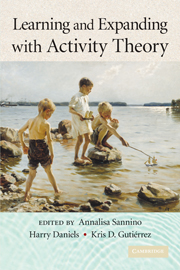Book contents
- Frontmatter
- Contents
- Contributors
- Editors' introduction
- 1 Activity Theory Between Historical Engagement and Future-Making Practice
- PART ONE UNITS OF ANALYSIS
- PART TWO MEDIATION AND DISCOURSE
- PART THREE EXPANSIVE LEARNING AND DEVELOPMENT
- PART FOUR SUBJECTIVITY, AGENCY, AND COMMUNITY
- PART FIVE INTERVENTIONS
- Bibliography
- Author Index
- Subject Index
1 - Activity Theory Between Historical Engagement and Future-Making Practice
Published online by Cambridge University Press: 05 June 2012
- Frontmatter
- Contents
- Contributors
- Editors' introduction
- 1 Activity Theory Between Historical Engagement and Future-Making Practice
- PART ONE UNITS OF ANALYSIS
- PART TWO MEDIATION AND DISCOURSE
- PART THREE EXPANSIVE LEARNING AND DEVELOPMENT
- PART FOUR SUBJECTIVITY, AGENCY, AND COMMUNITY
- PART FIVE INTERVENTIONS
- Bibliography
- Author Index
- Subject Index
Summary
Activity theory seeks to analyze development within practical social activities. Activities organize our lives. In activities, humans develop their skills, personalities, and consciousness. Through activities, we also transform our social conditions, resolve contradictions, generate new cultural artifacts, and create new forms of life and the self.
The legitimacy of activity theory as a unified theory has been the subject of various discussions. Holzman (2006), for example, argues that there is no unified perspective on activity theory. Holzman uses the term “activity theory” to cover a wide variety of approaches inspired by Vygotsky: among others, cultural-historical activity theory and sociocultural psychology. Such a broad view of activity theory contributes to a misrepresentation of the theory as fragmented and scattered across multiple perspectives. Further, this view brings with it the risk of losing focus on the actual nature of activity, which is the core of activity theory. An emphasis on psychological approaches without consideration of anthropological, sociological, historical, and linguistic characteristics of activity is risky and narrows the focus to the study of specific and limited aspects of activity. As a unified theory, activity theory has shown consistent viability throughout its history, beginning in the 1930s when Leont'ev formulated its basic principles and proposed the structure of activity. In addition, activity theory today attracts more interest globally than ever before. The term “unified” does not refer to a closed and fixed theory. However, it rules out an interpretation of activity theory as an eclectic grouping of multiple theories.
- Type
- Chapter
- Information
- Learning and Expanding with Activity Theory , pp. 1 - 16Publisher: Cambridge University PressPrint publication year: 2009
- 19
- Cited by



